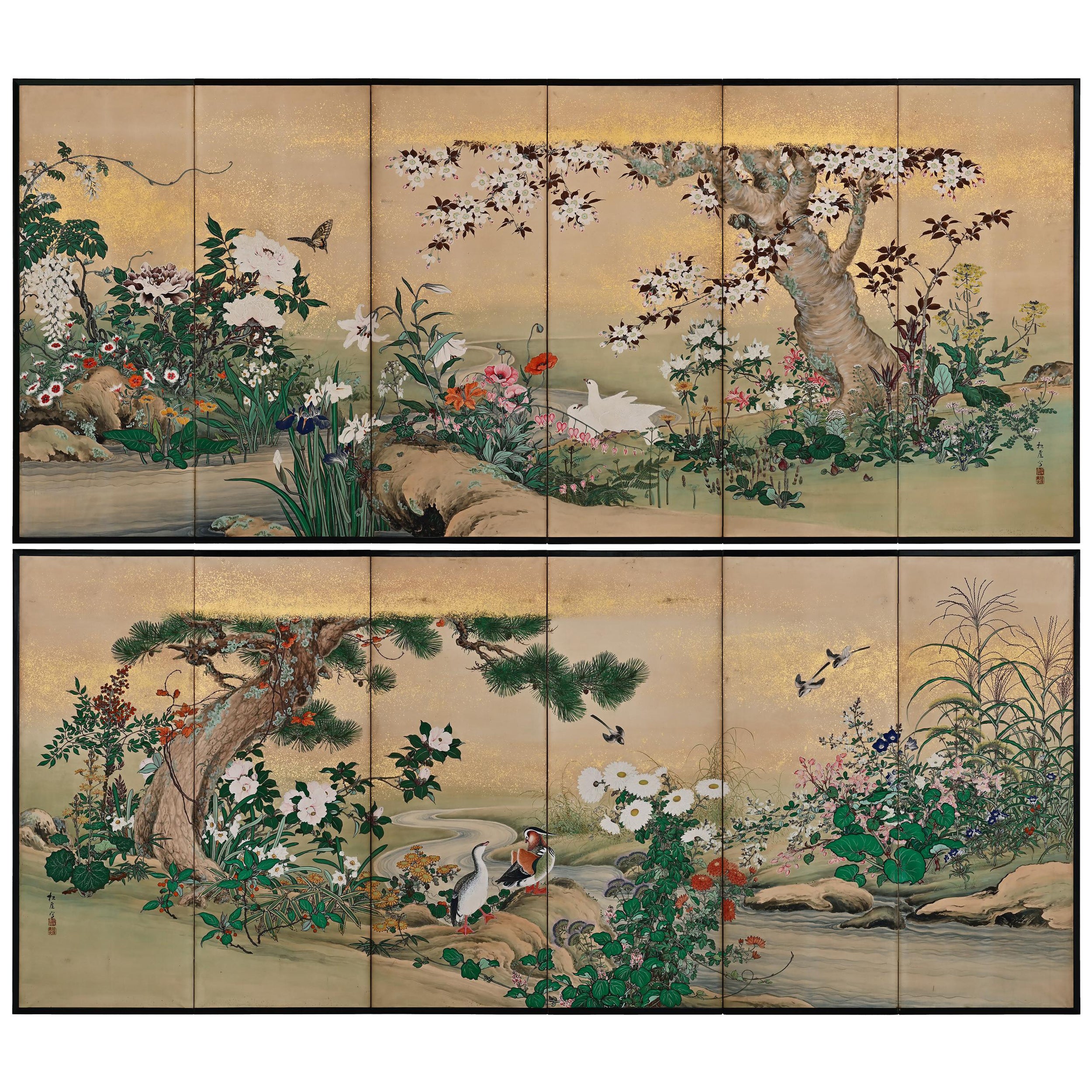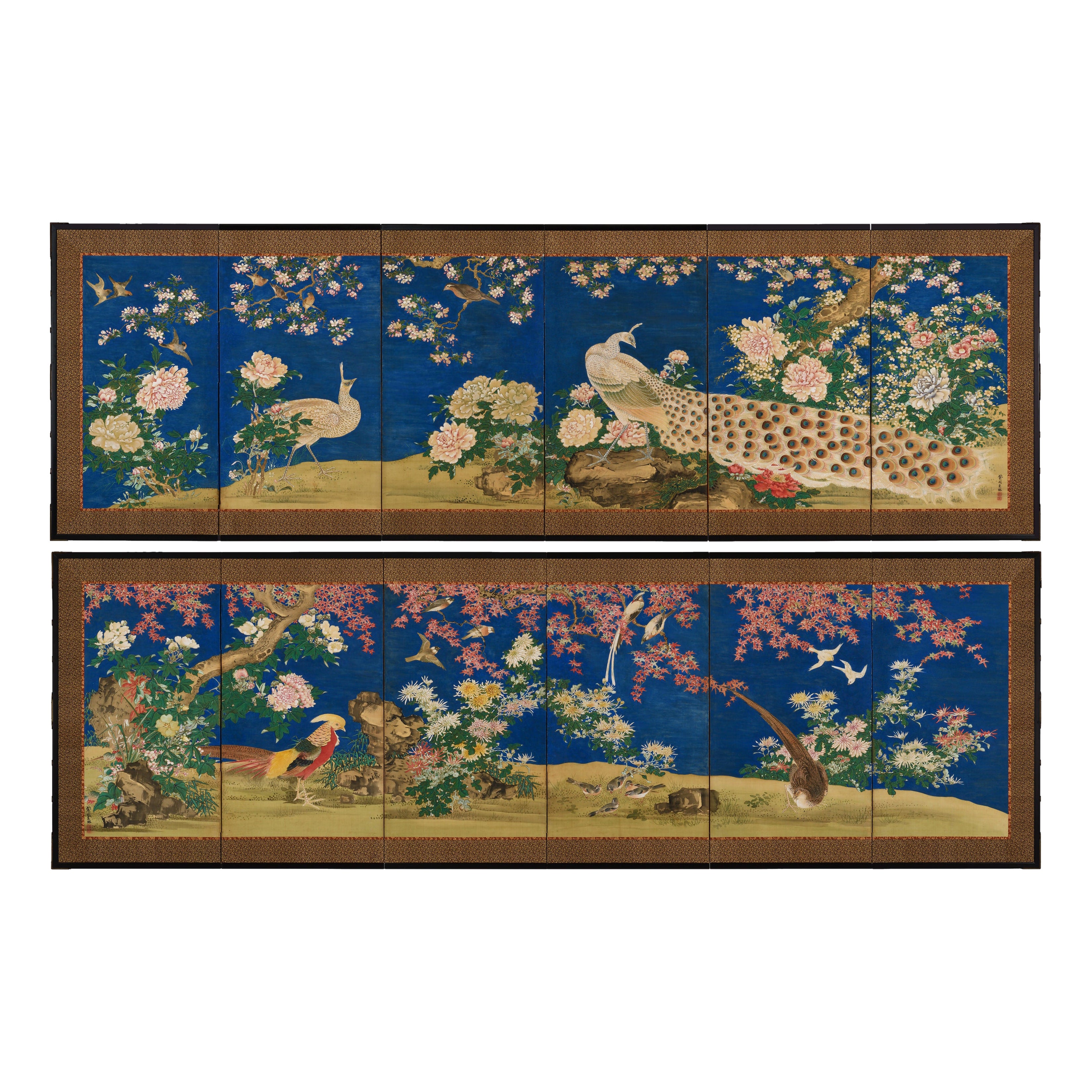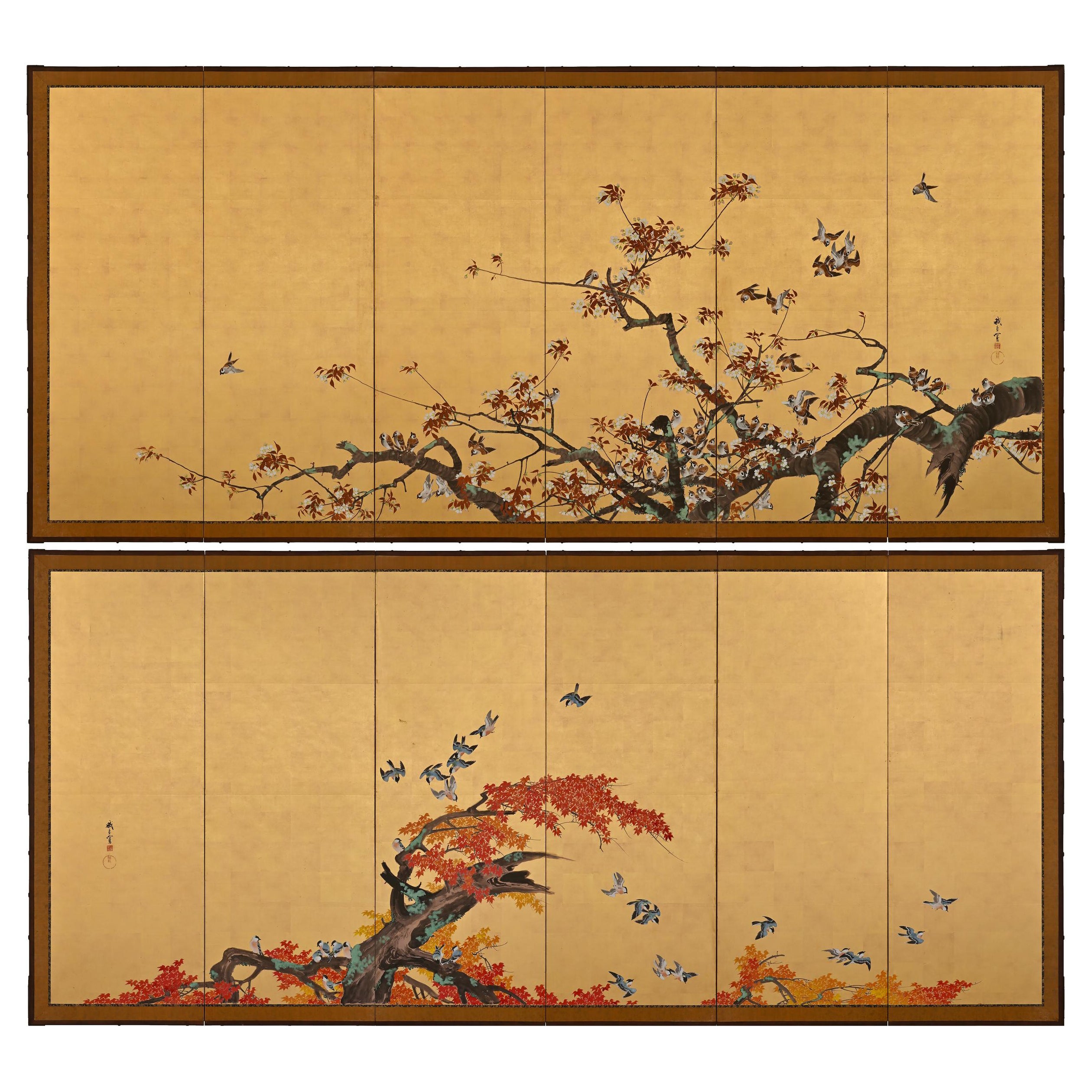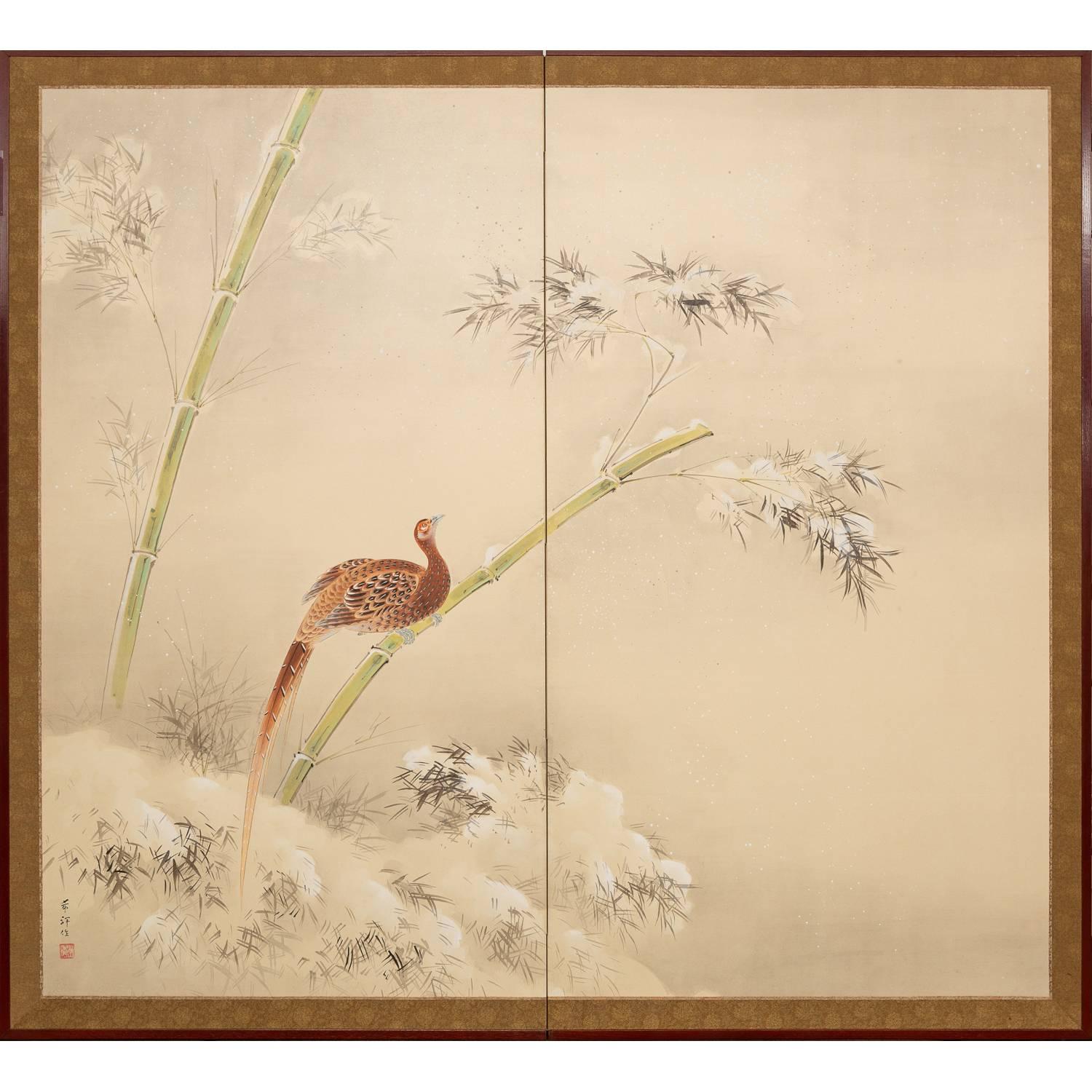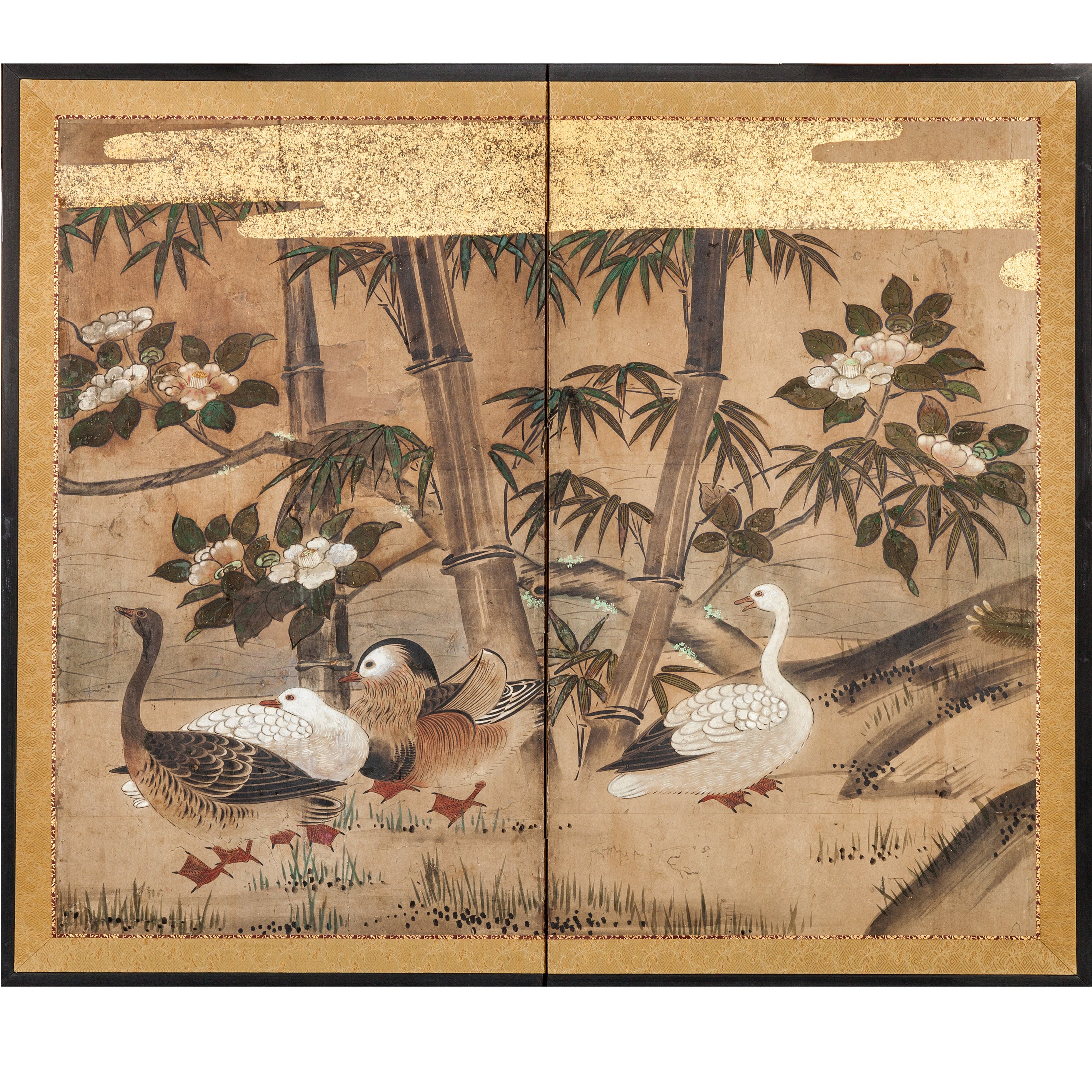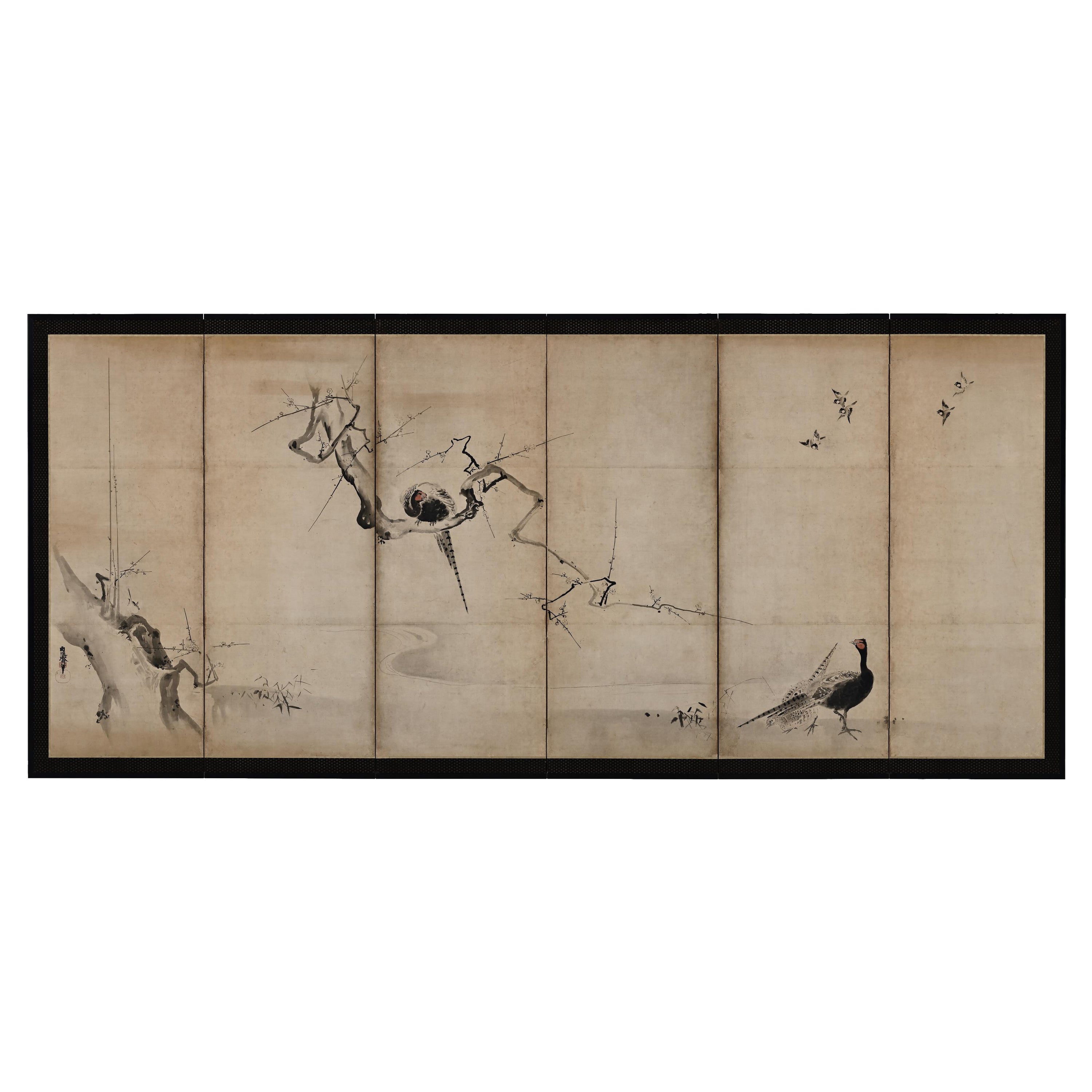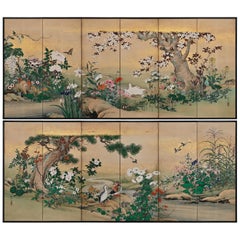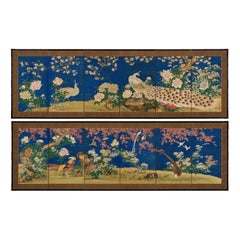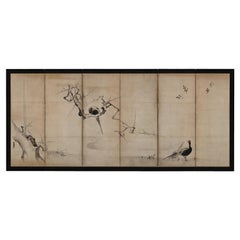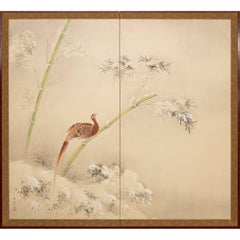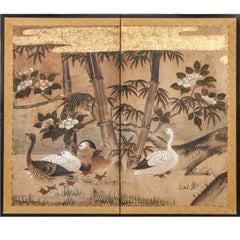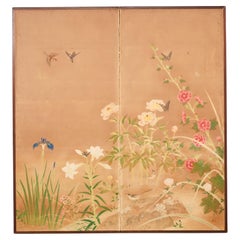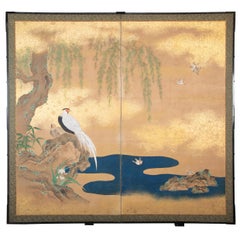Items Similar to Early 19th Century Japanese Screen. Cherry Blossom & Pheasants by Mori Tetsuzan
Want more images or videos?
Request additional images or videos from the seller
1 of 8
Early 19th Century Japanese Screen. Cherry Blossom & Pheasants by Mori Tetsuzan
$29,500
£22,383.92
€25,594.01
CA$41,203.50
A$45,812.69
CHF 23,920.86
MX$557,651.95
NOK 305,219.72
SEK 285,976.29
DKK 191,012.82
Shipping
Retrieving quote...The 1stDibs Promise:
Authenticity Guarantee,
Money-Back Guarantee,
24-Hour Cancellation
About the Item
Mori Tetsuzan (1775-1841)
Pheasants and Cherry Blossoms
Two-fold Japanese screen. Ink, color, gofun, gold and silver on paper.
A two-fold Japanese bird and flower screen by the 19th century artist Mori Tetsuzan. The pheasants are rendered in a highly realistic style, owing to Tetsuzan’s careful observation of birds in nature. The delicate cherry blossoms and red leaves are also highly naturalistic, as is the twisting of the tree’s trunk and branches. These are gracefully contrasted with the simplified suggestions of the surrounding landscape, sparingly indicated and obscured by clouds of gold. Tetsuzan presents a warm world that captures the idyllic scenery in early spring. The scene encapsulates the popular Kyoto-based Maruyama-Shijo School style of painting in its fine balance of beautiful, deceptively simple design and detailed surface description.
Like his teacher, Maruyama Okyo, Tetsuzan largely eschewed painting phoenixes, dragons and other mythological creatures, as his interest lay in the world around him. He tried to capture the charm of everyday scenes. Depicted here are a pair of Green Pheasants, the national bird of Japan. They inhabit the farmlands and marshes of most of Japan, and many live near villages and towns: they are a very familiar bird, particularly in pre-industrial Japan. Despite this they are not widely represented in Japanese painting, Chinese Golden and Silver Pheasants being far more common.
Mori Tetsuzan (1775-1841) was the son of Mori Shuho (brother of Mori Sosen), and succeeded the family from Sosen. Together they formed a painting school known as the Mori school that was active in the Osaka area. Tetsuzan originally studied under Sosen, but later became a disciple of Maruyama Okyo. He is known as one of the ten disciples of Okyo. Tetsuzan passed his techniques on to Mori Kansai and Mori Ippo.
- Dimensions:Height: 69 in (175.26 cm)Width: 75 in (190.5 cm)Depth: 0.75 in (1.91 cm)
- Style:Edo (Of the Period)
- Materials and Techniques:
- Place of Origin:
- Period:
- Date of Manufacture:Circa 1820
- Condition:Wear consistent with age and use.
- Seller Location:Kyoto, JP
- Reference Number:1stDibs: LU2472331314422
About the Seller
5.0
Recognized Seller
These prestigious sellers are industry leaders and represent the highest echelon for item quality and design.
Established in 2001
1stDibs seller since 2016
70 sales on 1stDibs
Typical response time: 6 hours
- ShippingRetrieving quote...Shipping from: Kyoto, Japan
- Return Policy
Authenticity Guarantee
In the unlikely event there’s an issue with an item’s authenticity, contact us within 1 year for a full refund. DetailsMoney-Back Guarantee
If your item is not as described, is damaged in transit, or does not arrive, contact us within 7 days for a full refund. Details24-Hour Cancellation
You have a 24-hour grace period in which to reconsider your purchase, with no questions asked.Vetted Professional Sellers
Our world-class sellers must adhere to strict standards for service and quality, maintaining the integrity of our listings.Price-Match Guarantee
If you find that a seller listed the same item for a lower price elsewhere, we’ll match it.Trusted Global Delivery
Our best-in-class carrier network provides specialized shipping options worldwide, including custom delivery.More From This Seller
View All19th Century Japanese Screen Pair. Flowers & Birds of the Four Seasons
Located in Kyoto, JP
Flowers & Birds of the Four Seasons
Pair of six-fold Japanese Screens. Ink, color, gofun and gold on paper.
Second half of the 19th Centur...
Category
Antique Late 19th Century Japanese Meiji Paintings and Screens
Materials
Wood, Paper
Mid 19th Century Japanese Screen Pair. Flowers & Birds of the Four Seasons.
Located in Kyoto, JP
Shioka Sorin (1781-1850)
Flowers & Birds of the Four Seasons
Pair of six-panel Japanese Screens. Ink, gofun and pigments on silk.
Dimensions (each screen): H. 91.5cm x W. 285cm (3...
Category
Antique Mid-19th Century Japanese Edo Paintings and Screens
Materials
Silk
Meiji Era, Circa 1900 Japanese Screen Pair, Flowers & Birds of Spring & Autumn
Located in Kyoto, JP
Flowers & Birds of Spring and Autumn
Unknown artist.
Japan. Meiji period, circa 1900.
A pair of six-fold screens. Ink, color, gofun and gold leaf on paper.
Signed: Gaga S...
Category
Antique 1890s Japanese Meiji Paintings and Screens
Materials
Gold Leaf
17th Century Japanese Screen. Ink Plum Tree & Birds by Kano Naonobu.
Located in Kyoto, JP
Kano Naonobu (1607-1650)
Plum Tree and Birds
Six-fold Japanese Screen. Ink and slight color on paper.
In this evocative ink work spread over a six-panel folding screen, we see the consummation of the elegance and refinement of the Edo Kano school. This 17th century screen is a rare surviving example of a large-scale bird and flower painting by Kano Naonobu, the younger brother of Kano Tanyu...
Category
Antique 17th Century Japanese Edo Paintings and Screens
Materials
Wood, Paper
17th Century Japanese Screen Pair by Soga Nichokuan, Hawks on Pine & Plum Trees
Located in Kyoto, JP
Hawks on plum and pine
Soga Nichokuan (active circa 1625-1660)
Pair of six-fold screens.
Ink, mineral pigments, gofun, gold and speckled gold l...
Category
Antique 1640s Japanese Edo Paintings and Screens
Materials
Wood, Paper
Early 20th Century Japanese Cherry Blossom Screen by Kano Sanrakuki
Located in Kyoto, JP
Cherry Blossoms
Kano Sanrakuki (1898-1981)
Showa period, circa 1930
2-panel Japanese Screen
Color, gofun and gold leaf on paper
Against a backdrop of gold-leafed ground, the lichen covered trunk and branches of the life-sized cherry blossom tree reach out and beyond the confines of the pictorial surface. The overall composition has a feeling of flatness which draws emphasis to the surface and the three-dimensionality of the cherry blossoms. Painstakingly built-up layers of thickly applied shell-white gofun detail the voluminous blossoms and cover large areas of this tour-de-force of Japanese Nihonga painting. By simplifying the background, minimizing the number of colors and depicting the blossoms with such heavy relief, the artist has emphasized the stunning presence of the cherry tree. The type of tree depicted is the Yae-Zakura; a double-layered type of cherry blossom famed for its beauty and strength. When we think of Japanese cherry blossoms, the first thing that comes to mind is Somei Yoshino variety, which has a single flower with five almost white petals. This type is fragile and easily blown away by strong wind or rain. Most of the double-flowered cherry blossoms begin to bloom when the Somei-Yoshino falls, and the flowering period lasts longer than that of the Somei-Yoshino.
Kano Sanrakuki originally studied painting at the Kyoto City Arts and Crafts School under the tutelage of Yamamoto Shunkyo...
Category
Early 20th Century Japanese Showa Paintings and Screens
Materials
Gold Leaf
You May Also Like
Japanese Two Panel Screen: Pheasant and Snow Covered Bamboo
Located in Hudson, NY
Early Taisho period painting (1912 - 1926) in mineral pigments on mulberry paper with a silk brocade border. Artist signature reads: Kisho saku. Kisho Shibahara (1885-1954).
Category
Early 20th Century Japanese Taisho Paintings and Screens
Materials
Paper
Japanese Two Panel Screen: Mandarin Ducks and Geese Among Bamboo and Flowers
Located in Hudson, NY
Japanese Two Panel Screen: Mandarin Ducks and Geese Among Bamboo and Flowers, Edo period painting (c. 1850) of mandarin ducks and geese on a grassy sh...
Category
Antique Mid-19th Century Japanese Edo Paintings and Screens
Materials
Gold
Japanese Showa Two Panel Screen Spring Flora and Fauna
Located in Rio Vista, CA
Spectacular Japanese Showa period two panel byobu screen featuring spring blossoms, birds, and butterflies. Beautifully detailed iris, lily, rose of sharon, wild pinks, morning glory...
Category
20th Century Japanese Showa Paintings and Screens
Materials
Wood, Paper
Japanese Meiji Period Painted Screen with Gold Fleck Paint
Located in Stamford, CT
Japanese Meiji period (1868-1912) painted screen with gold fleck paint. Remounted during Showa period (1926-1989).
Category
Antique Late 19th Century Japanese Meiji Paintings and Screens
Materials
Silk
Antique 19th Century Japanese Two-Panel Screen ‘Byobu’, Kano School, Edo Period
Located in London, GB
Japanese Kano School Edo period two-panel screen depicting flowering prunus and bamboo on a rock formation, with colorful birds next to a body of water. ...
Category
Antique Mid-19th Century Japanese Edo Paintings and Screens
Materials
Gold Leaf
Japanese "Magpie and Peony" Two Panel Screen, Edo Period, 18th/19th century
Located in Austin, TX
A sublime Japanese two panel "Magpie and Peony" screen, ink and color on paper, Edo Period, late 18th or early 19th century, circa 1800, Japan.
The two panel screen features a wond...
Category
Antique Early 19th Century Japanese Edo Paintings and Screens
Materials
Copper
More Ways To Browse
Japanese Hand Warmer
Pheasant Art
Chinese Japanese Screens
Antique Cherry Blossom
Japanese Cherry Tree
Red Chinese Screen
Cherry Blossom Design
Japanese Screen Silver
Japanese Screens Flowers
19th Century Chinese School
Gold Chinese Screen
Chinese Silk Screen
Cherry Blossom Painting Japanese
Antique Chinese Painting Of Birds
Asian Screens Green
Gold Pheasant
Japanese Screen Tree
Chinese Cherry Blossom
